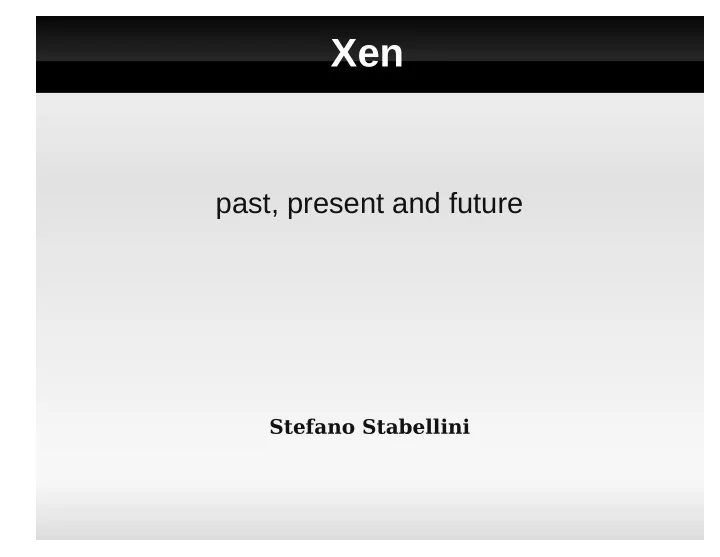

Xen past, present and future Stefano Stabellini
Xen architecture: PV domains
Xen arch: driver domains
Xen: advantages - small surface of attack - isolation - resilience - specialized algorithms (scheduler)
Xen and the Linux kernel Xen was initially a university research project invasive changes to the kernel to run Linux as a PV guest even more changes to run Linux as dom0
Xen and the Linux kernel Xen support in the Linux kernel not upstream Great maintance effort on distributions Risk of distributions dropping Xen support
Xen and the Linux kernel - PV support went in Linux 2.6.26 - basic Dom0 support went in Linux 2.6.37 - Netback went in Linux 2.6.39 - Blkback went in Linux 3.0.0 A single 3.0.0 Linux kernel image boots on native, on Xen as domU, as dom0 and PV on HVM guest
Xen and Linux distributions 2010 - Fedora and Ubuntu dropped Xen support from their Linux kernels - Debian, Suse, Gentoo still provide Xen kernels - XenServer went Open Source with XCP Present - Fedora and Ubuntu are adding Xen support back in kernel in the next releases
Xen architecture: HVM domains
Xen architecture: stubdoms
Xen and Qemu - initially forked in 2005 - updated once every few releases - Xen support went in upstream Qemu at the beginning of 2011 - Upstream Qemu is going to be used as device model with Xen 4.2
New developments: Libxenlight Multiple toolstacks: - Xend, Xapi, XenVM, LibVirt, … - code duplications, inefficiencies, bugs, wasted efforts Xend: - difficult to understand, modify and extend - significant memory footprint
Libxenlight What is Libxenlight: - a small lower level library in C - simple to understand - easy to modify and extend Goals: - provide a simple and robust API for toolstacks - create a common codebase to do Xen operations
XL - the unit testing tool for libxenlight - feature complete - a minimal toolstack - compatible with xm Do more with less!
XL: design principles - smallest possible toolstack on top of libxenlight - stateless CLI → XL → libxenlight → EXIT
XL vs. Xend XL: pros - very small and easy to read - well tested - compatible with xm Xend: pros - provide XML RPC interface - provide ”managed domains”
Libxenlight: the new world
Linux PV on HVM paravirtualized interfaces in HVM guests
Linux as a guests: problems Linux PV guests have limitations: - difficult “different” to install - limited set of virtual hardware Linux HVM guests: - install the same way as native - very slow
Linux PV on HVM: the solution - install the same way as native - PC-like hardware - access to fast paravirtualized devices - exploit nested paging
Linux PV on HVM: initial feats Initial version in Linux 2.6.36: - introduce the xen platform device driver - add support for HVM hypercalls, xenbus and grant table - enables blkfront , netfront and PV timers - add support to PV suspend/resume - the vector callback mechanism
Old style event injection
Receiving an interrupt do_IRQ handle_fasteoi_irq handle_irq_event xen_evtchn_do_upcall ack_apic_level ← >=3 VMEXIT
The new vector callback
Receiving a vector callback xen_evtchn_do_upcall
Linux PV on HVM: newer feats Later enhancements (2.6.37+): - ballooning - PV spinlocks - PV IPIs - Interrupt remapping onto event channels - MSI remapping onto event channels
Interrupt remapping
MSI remapping
PV spectrum HVM guests Classic Enhanced Hybrid PV PV guests PV on HVM PV on HVM on HVM oot emulated emulated emulated paravirtualized sequence Memory hardware hardware hardware paravirtualized nterrupts emulated emulated paravirtualized paravirtualized imers emulated emulated paravirtualized paravirtualized pinlocks emulated emulated paravirtualized paravirtualized isk emulated paravirtualized paravirtualized paravirtualized etwork emulated paravirtualized paravirtualized paravirtualized rivileged hardware hardware hardware paravirtualized perations
Benchmarks: the setup Hardware setup: Dell PowerEdge R710 CPU: dual Intel Xeon E5520 quad core CPUs @ 2.27GHz RAM: 22GB Software setup: Xen 4.1, 64 bit Dom0 Linux 2.6.32, 64 bit DomU Linux 3.0 rc4, 8GB of memory, 8 vcpus
PCI passthrough: benchmark PCI passthrough of an Intel Gigabit NIC CPU usage: the lower the better: 200 180 160 140 120 CPU usage domU 100 CPU usage dom0 80 60 40 20 0 interrupt remapping no interrupt remapping
Kernbench Results: percentage of native, the lower the better 140 135 130 125 120 115 110 105 100 95 90 PV on HVM 64 bit PV on HVM 32 bit HVM 64 bit HVM 32 bit PV 64 bit PV 32 bit
PBZIP2 Results: percentage of native, the lower the better 160 150 140 130 120 110 100 PV on HVM 64 bit PV 64 bit PV on HVM 32 bit PV 32 bit
SPECjbb2005 Results: percentage of native, the higher the better 100 90 80 70 60 50 40 30 20 10 0 PV 64 bit PV on HVM 64 bit
Iperf tcp Results: gbit/sec, the higher the better 8 7 6 5 4 3 2 1 0 PV 64 bit PV on HVM 64 bit PV on HVM 32 bit PV 32 bit HVM 64 bit HVM 32 bit
Conclusions PV on HVM guests are very close to PV guests in benchmarks that favor PV MMUs PV on HVM guests are far ahead of PV guests in benchmarks that favor nested paging
Questions?
Recommend
More recommend